
Sailing into the third trimester like a champ!
If you’re excited and anxious in equal parts about your third trimester, don’t worry – you are not alone! It’s totally normal. Your body is going through massive changes and baby will really pack on the pounds in the last few weeks of your pregnancy. We’ll cover how to stay active during your last trimester, as well as how to physically prepare for your birth experience during the final crucial weeks. Given the huge changes to your body, the routines that I recommend for third trimester exercise are gentler, lighter and put less strain on your abdominals and pelvic floor. During this last phase, your priorities should be:
- Maintaining a comfortable and healthy level of activity
- Reducing any physical discomfort arising from your pregnancy
- Preparing your body for birth
Jump to:
Maintaining a comfortable level of activity
Third trimester exercises
Preparing your body for birth
Things to watch out for during your third trimester
Your third trimester exercise program
Read more: Pre And Postnatal Fitness Part 1: Safe Exercise For The First Trimester

Maintaining a comfortable level of activity
This is not the time to push yourself with super strenuous activities. After all, you will already be feeling tired and possibly sore from carrying the baby. Instead, focus on rest, recovery and gentle activities. I always say that you should leave an exercise session feeling better and more energised than when you started. If that means taking longer rests between exercises, giving yourself more time to recover between sessions and even cutting certain sessions short, that is totally okay.
So what can you do, and what can’t you do? The answer is that every woman is slightly different. Some mums will feel fitter and stronger at this stage than others, and others will feel a little less capable. Wherever you feel you are on the spectrum, don’t worry. The key is just to take things a little easier than you normally would and to pay close attention to how you feel. Exercise at this stage should never leave you exhausted and aching.
Make sure to listen to your body closely when doing any training during this final trimester. You can afford to cut yourself some slack. Like I’ve mentioned, your body is already working very hard just to support you and baby. It can be difficult just to get a good night’s sleep when you are constantly getting up to pee and it feels like the baby is having a party in your belly! At this stage, it’s okay to feel wiped out or exhausted every so often. That said, if you feel chronically tired, it is best to seek medical help just to stay on the safe side of things. For example, it’s not uncommon for mums to develop an iron deficiency in their last trimester. Luckily, this can be tested for and treated easily by your family doctor.
Read more: Pre And Postnatal Fitness Part 2: Safe Second Trimester Exercise
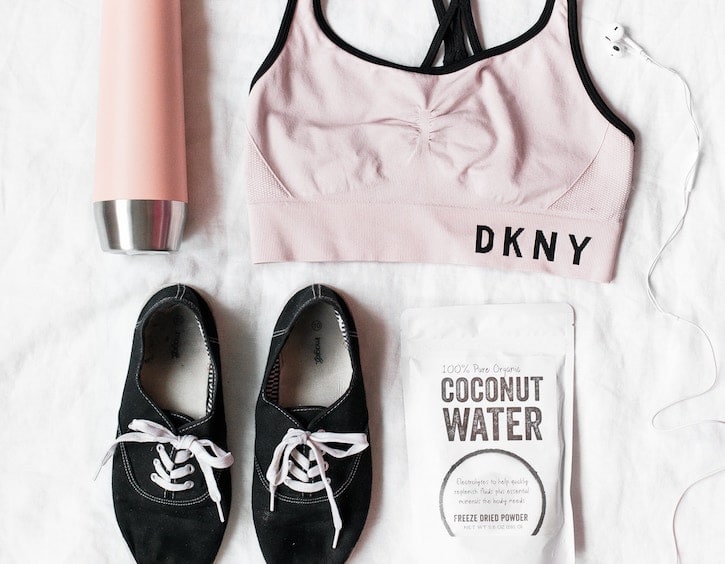
Practically speaking, now is probably a good time to put high-intensity interval training (HIIT) exercises on hold. This is for a couple of good reasons. First, you’ll find your cardio capacity has decreased because your growing baby is putting more pressure on your diaphragm. Plus, you are also now pumping around 25% more blood around your system and your body has started packing on extra pounds in preparation for birth.
If you love to walk, you may also want to reduce the length of your walks, or at least intersperse them with longer breaks to give your body more time to recover. This is not only because of the extra cardiovascular load your body is experiencing, but also to reduce excess strain on your pelvic floor as baby gets heavier.
Instead, here are some useful and gently modified exercises that will give you the advantages of keeping active, while not sapping your strength. After all, prenatal exercise should be supporting your baby’s development and not competing with it.
Third trimester exercises
Swiss ball pelvic tilts and circles
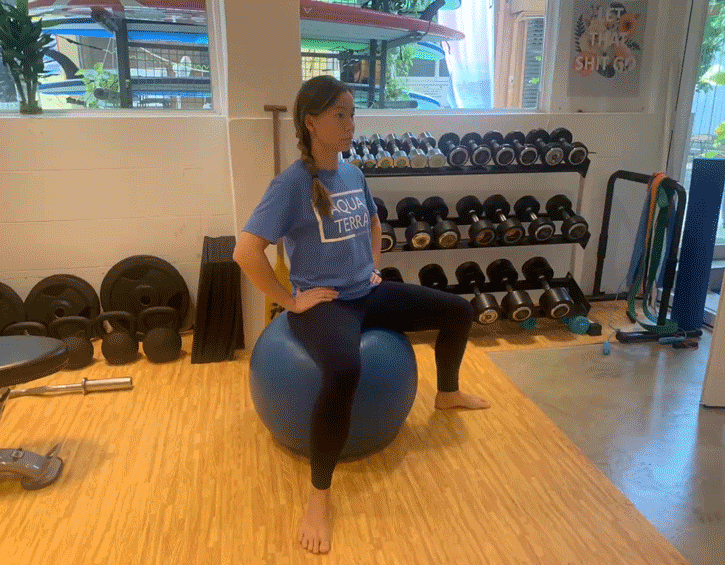
Pelvic tilts and circles are great for your pelvic mobility and getting baby into better alignment for birth. Plus, they feel great! Find a good quality stability ball – and remember that sizing is important. Choose a big enough ball that when you sit on it your bottom is level with your knees.
Cues:
- Sit on the centre of the ball.
- Place your knees wide, making sure your feet are firmly on the ground.
- Your toes can point outwards, and you can place your hands on your hips.
- Sit up straight with your head, shoulders and hips aligned vertically on top of one another.
- Begin moving your hips anticlockwise, so that the ball rolls in a small circle underneath you. Your feet should stay firmly on the ground as you do this.
- Repeat this motion in a clockwise direction.
- You can also rock your pelvis forwards and backwards as well as from one side to the other.
T-spine mobiliser and chest opener
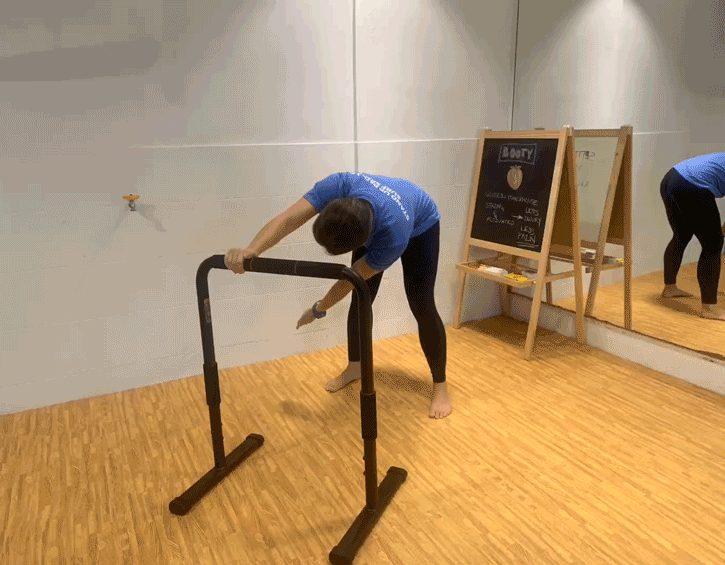
This is great to get some movement in your upper body, especially if you’ve been hunched over a computer all day and your back is feeling stiff.
Cues:
- Find a table or ledge. Place both hands on one edge and step back so that you are bent over, hinging at your hips. Your knees should be soft and both your feet should be firmly on the ground.
- Raise your left arm up to the sky and then down and across your chest until it comes under your right armpit. Follow your hand with eyes and try to keep your hips square while moving your arm.
- Repeat on the other side.
Standing banded face pull
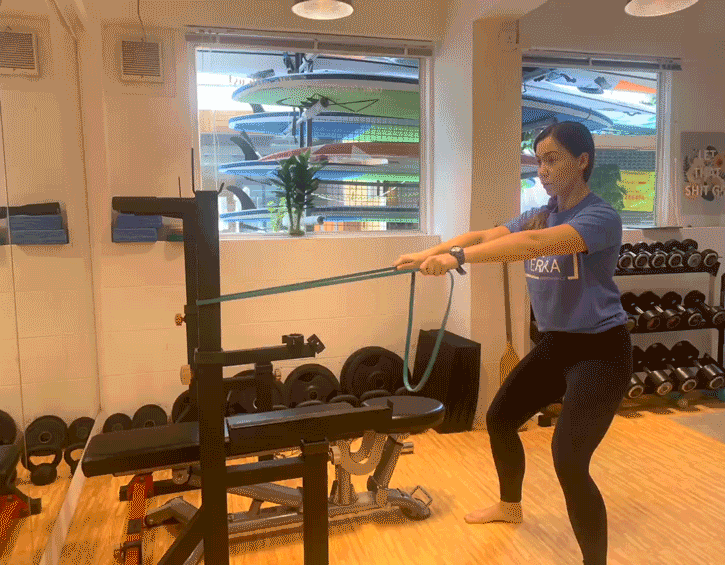
The face pull is a great exercise for strengthening the upper back. You’ll need a strong back not only during pregnancy but as a new mother – it’s no secret that motherhood is a 24-hour job!
As your baby grows, so does the amount of weight you will be carrying on your arms, chest and back. This exercise will help you prepare for that. You can do it on a cable machine, or by using a long resistance band looped around a fixed object like a pillar or a tree.
Cues:
- Loop your band around a secure object at shoulder height or slightly below (if you are using a resistance band).
- Grip your band or cable attachment with both hands and make sure that your thumbs are on the inside, facing each other. Your palms should be facing the floor.
- Walk away from the anchor or the cable machine, so that you have tension in the band.
- Set your feet shoulder-width apart and soften your knees.
- Exhale and pull the band or cable towards your face until your hands reach the line of your ears. As the tension in the band builds, make sure you are squeezing your shoulder blades together to engage your back muscles. Don’t be tempted to cheat the exercise by leaning back and thrusting your hips or chest forward. Maintain optimal alignment and avoid putting any strain on your belly by keeping your ribcage down and your chin tucked in.
- Inhale and slowly release your arms back to full extension.
Swiss ball wall squat
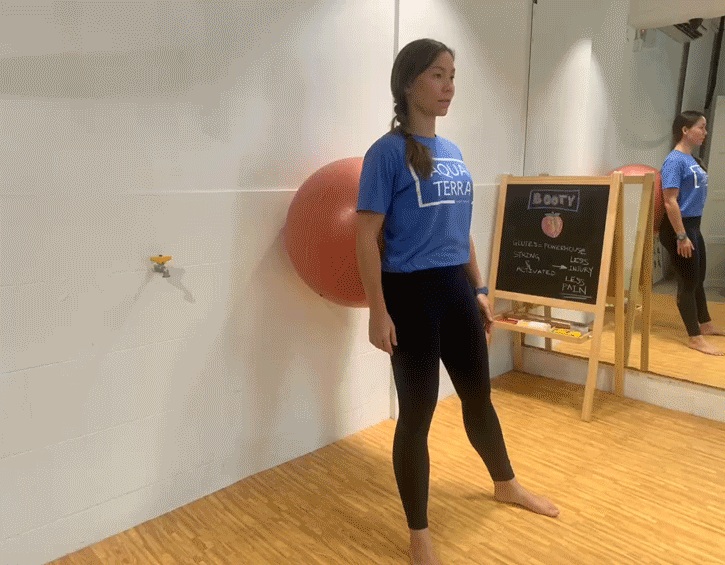
This is another great way to use an exercise ball during your routine. This squat modification is perfect for your third trimester because you are supported against a wall and this removes some pressure on your pelvic floor, but you’ll still get a great leg workout.
Cues:
- Place the Swiss ball behind you, between the curve of your lower back and a flat wall.
- Lean against the ball and walk your legs slightly forward and out. This is because when you come down in the squat you don’t want your knees tracking forward of your toes.
- Initiate the squat by letting your back roll down the side of the ball and bringing your bum towards the floor. Breathe in as you go down and reduce the range of motion if you feel any discomfort.
- When your bum is level with your knees (or at a comfortable height for you) exhale to stand and imagine pushing the floor away with your feet to come back to your starting position. Remember to avoid holding your breath at any point as this will put too much pressure on your pelvic floor.
- When performing the wall squat, imagine your torso moving up and down in a straight line.
Sassy Mama tip: Reducing physical discomfort
It’s no secret that your pregnant body can sometimes feel sore and battered, and most mamas-to-be will face at least one of these problems. Luckily, getting active and mobilising the correct muscles can work wonders at the beginning to relieve some of these niggles.
Sassy Mama tip: Relieving lower back pain
You might already have had run-ins with lower back pain earlier in pregnancy, which you might be experiencing more in your third trimester. This is not uncommon. Your bump is getting bigger and heavier and your body is producing more of a hormone called relaxin, which loosens up your ligaments. This is the perfect storm for back pain if you have pre-existing issues with alignment. Fortunately, stretching exercises like the Cat-Cow can make a big difference for many women in relieving the strain.
Cat-Cow
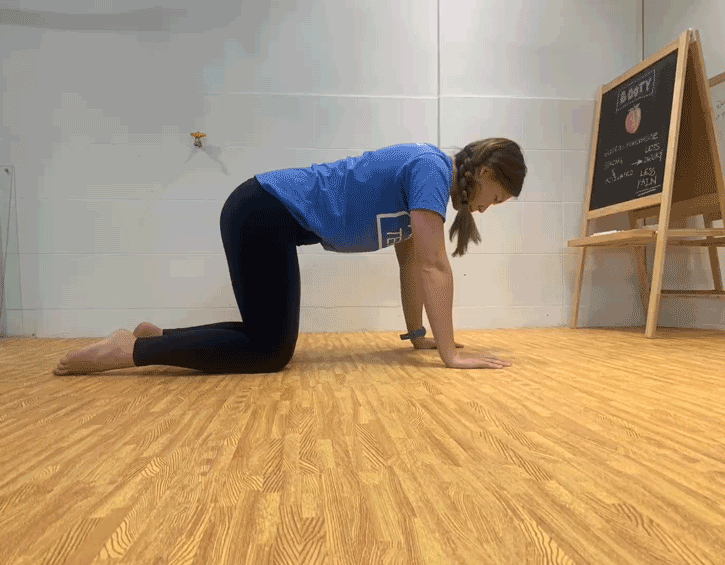
Cat cow is a classic stretch to relieve back pain. But, watch your technique on the cat phase. You don’t want to be excessively arching by hyperextending your neck up and thrusting your butt into the air. Instead, think about keeping your back flat and pulling your shoulder blades down and back. Don’t point your chin towards the sky – this is especially important if you suspect that you have diastasis recti.
Cues:
- Get into a tabletop position on your hands and knees. Your hands should be vertically below your shoulders and your knees should be under your hips (if you have carpal tunnel syndrome or wrist pain, place a rolled-up towel or yoga mat under your palms.)
- Push against the floor with your hands and let your upper back rise towards the sky as you exhale. This is the cow pose.
- When you inhale, gently pull your shoulder blades down and back. Think about spreading your collarbones as you do this. This is the cat pose.
Wide child’s pose
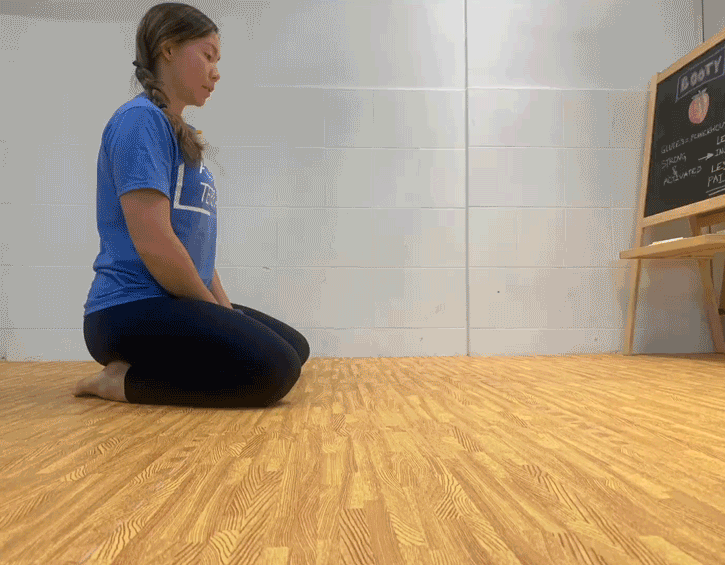
This is a classic yoga pose that is great for relaxation. It can also help relieve back pain.
Cues:
- Sit back on your heels with your feet close together and your knees spread wide.
- Keep your hips close to your heels and walk your hands forward, so that your bump sits snugly between your legs. You can add extra support by placing a cushion under your belly, but your bum should still be close to your heels.
- Some of you will be able to touch your forehead to the floor. If you can’t, don’t worry – never force it. You can also cross your forearms and rest your head on them.
- Practice 5 to 8 deep, calm, rhythmic breaths in this position (if you are ever unsure seek guidance from an expert).
And if you have a massage ball (or even a lacrosse or tennis ball) there are a number of great myofascial release exercises you can do at home for relief too:
If your back pain persists, I would recommend seeing your doctor or a women’s health physiotherapist to make sure there aren’t any underlying health issues.
Sassy Mama tip: Identifying diastasis recti
A lot of my clients get very concerned about diastasis recti (DR) in their third trimester. DR is when the fibrous sheath called the linea alba, which rests in the middle of your abdominal muscles, starts to bulge and stretch and your rectus abdominis muscles (better known as your abs) are pushed outwards by your growing baby. It’s commonly thought of by many people as “ab separation”.
Although it sounds very distressing, the fact is that almost 100% of women will develop some degree of DR during their last trimester. While I wouldn’t suggest that you can do exercises that are guaranteed to stop DR, I do believe that you can avoid certain exercises that exacerbate DR and increase the length of your postpartum recovery. Now is also the time to lower the weights in your workout and that’s okay. Keep in mind that these changes to your exercise routine are not forever, but pushing beyond your body’s current capacity might have long-term effects.
Exercises to avoid at this stage are planks, crunches and other kinds of exercises that place a lot of load on your front. This can sometimes include overhead shoulder presses or bodyweight/inverted rows where the incline is too great. Instead, I would recommend a core exercise like a suitcase carry instead.
Suitcase carry
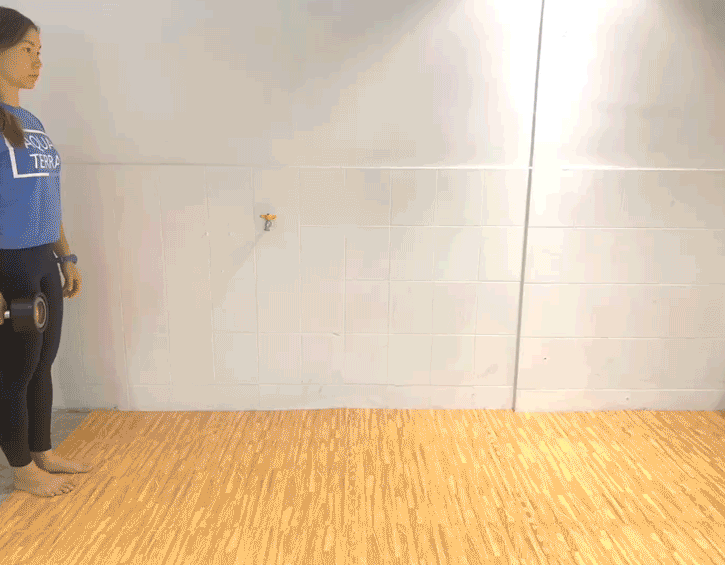
Cues:
- Pick up one dumbbell in your right hand. It should be heavier than the handbag you normally carry around with you.
- Stand up straight and pull your shoulder blades down and back.
- Hold the dumbbell down by your right side as if you are holding a suitcase.
- Keep your arm an inch from your body, keeping your shoulders pulled back and down.
- Engage your core muscles.
- Walk ten paces slowly in a straight line and then turn around and walk back to the start.
- Swap hands and repeat for the left side.
If you are concerned about DR and need more guidance on what exercises are suitable for you, I’d recommend that you find a women’s health physiotherapist, or a personal trainer like myself, who specialises in prenatal exercise to recommend a custom training plan for you.
Preparing your body for birth
Your last trimester is also a great time to give your pelvic floor muscles some love. In particular, you’ll want to train these muscles to relax during labour so that your baby can move more freely through your birth canal. This is especially important if you are a super active mum who loves high impact exercises. So how do you relax these often tight and overactive muscles?
The best way to get into the swing of breathing exercises is to do a bit of visualisation. It can get overwhelming when anatomical words like pelvic floor, diaphragm and transversus abdominis are thrown at you. I’ve got a bunch of cues in my toolbox and a good coach will help you find one that resonates best with you. For now, we’re going to start with one that we can all relate to!
Visualisation
Get into a comfortable sitting position and imagine you are on the loo ready to pee. Let your belly and your glutes relax. Next, feel the muscles around your vagina drop and open up as if you are about to go.
Once you’ve got the hang of this you can start combining this with the breathing exercise I touched upon in the second trimester guide. Ideally, you want to imagine your pelvic floor muscles descending and opening as you inhale and your abdomen fills with air.
If you are struggling to visualise these exercises within your body, or you haven’t quite found the cue that works for you, then please feel free to get in touch and I’d be more than willing to develop a set of birth prep exercises modified just for you. If you’ve got the technique down, a good app to help with pelvic floor exercises is the Squeezy App by the UK National Health Service (NHS). It sets reminders on your phone and tracks your exercises to make sure you’re doing enough!
Read more: 9 Health And Wellness Apps For Busy Hong Kong Mums
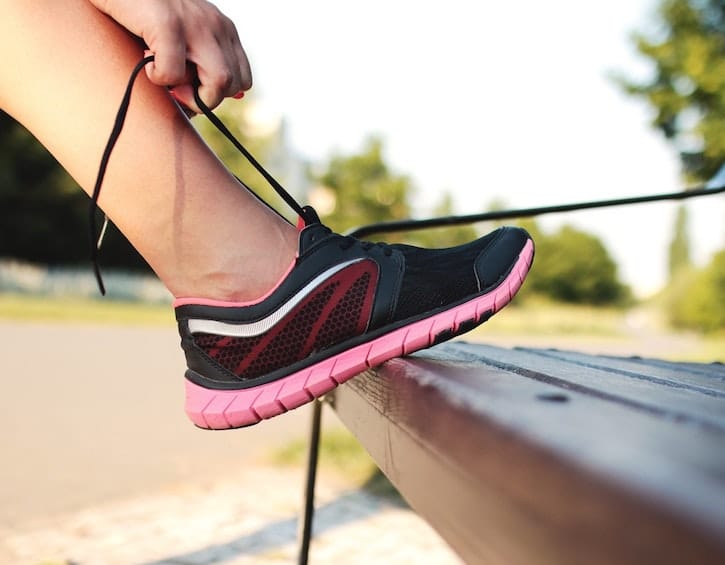
Things to watch out for during your third trimester
Before you get stuck into the sample third trimester training plan, I just want to share some extra advice in case you run into any of the following issues while exercising during this trimester.
Braxton hicks contractions
These are also known as “practice” contractions where the muscles of your uterus suddenly contract and get rock hard. Sometimes you won’t experience any pain and sometimes it’ll feel like a strong cramp. These contractions are sporadic and should come and go quite quickly. It can be helpful to change positions when they occur.
Pelvic girdle pain
You might experience a sharp pain in your hips, lower back or pubic region. The pain might get worse when you splay your legs wide, place more weight on one leg than the other, roll in and out of bed, climb stairs, get in or out of a car or even by walking. Your trainer should be able to help you modify the movement to reduce the pain and keep you moving, but your first option should be to contact your women’s health physiotherapist.
Baby Movements
Your baby might be moving a lot in your final trimester, often when you’re trying to wind down! Each baby has their own movement pattern and it’s important you get to know yours. You should always first assess that there is the usual amount of fetal movement before, during and after exercise. If there are any concerns, make sure you contact your nearest health practitioner as soon as possible.
Baby settling
Your baby might be moving a lot in your final trimester. If this gets super uncomfortable, stop training until baby is settled happily again.
Feeling dizzy while lying down
I’d recommend avoiding doing any exercises lying on your back during your third trimester because the weight of your baby can put pressure on an important blood vessel in your body and reduce blood flow. If you happen to be on your back and feeling faint or dizzy, roll to your left side to relieve this pressure and restore normal blood flow.
If you still want to do exercises like dumbbell bench presses in your third trimester then I would recommend using an incline bench at 15 degrees or above, rather than a flat bench. And, reduce the weights – now isn’t the time to go for a personal best!
Your third trimester exercise programme
Warm-up
Breathing Exercises
Recommended repetitions: 2 rounds of 8-10 breaths
Swiss Ball Pelvic Circles
Recommended repetitions: 10 circles clockwise and 10 circles anti-clockwise
T-spine mobiliser and chest opener
Recommended repetitions: 8-10 per side
Cat cow
Recommended repetitions: 8-10
Wide Child’s Pose
Recommended repetitions: Hold for a count of 5-8 continuous, rhythmic, breaths
The workout
A1. Swiss Ball Wall Squat
Recommended repetitions: 10-15
Recommended weight range: No weights or 4-6kg dumbbell in each hand if that feels too easy
Recommended rest: 30-60 seconds
A2. Standing Band Face Pull
Recommended repetitions: 10-15
Recommended weight range: Resistance band
Recommended rest: 30-60 seconds
A3. Suitcase Carry
Recommended repetitions: 10-12 paces per side
Recommended weight range: 6-14kg in one hand
Recommended rest: 30-60 seconds
Complete a total of 3-4 rounds
As always, make sure you have your doctor’s clearance to exercise during your pregnancy. And again, if you need specific guidance as to what is working and what is not working when exercising your pregnant body, please don’t hesitate to get in touch!
 View All
View All











 View All
View All





 View All
View All


 View All
View All











